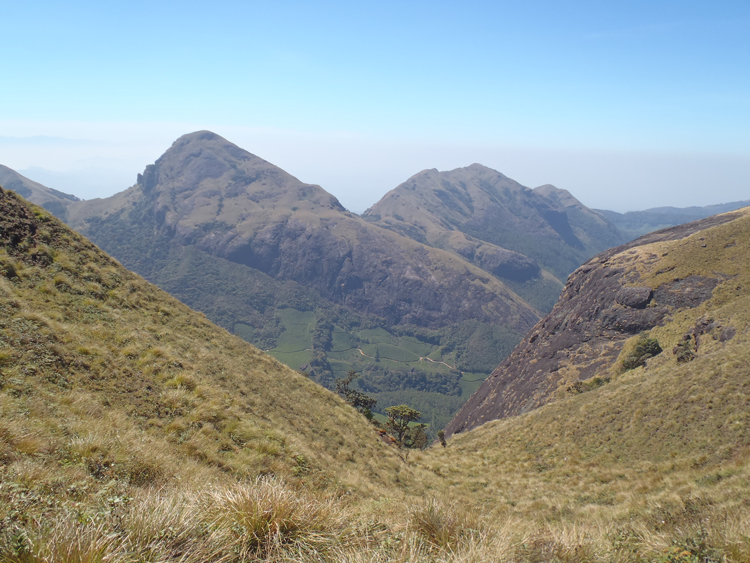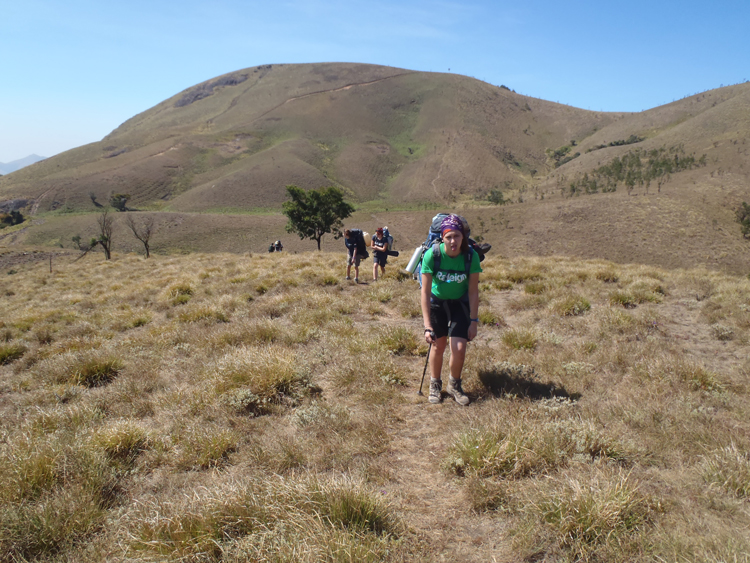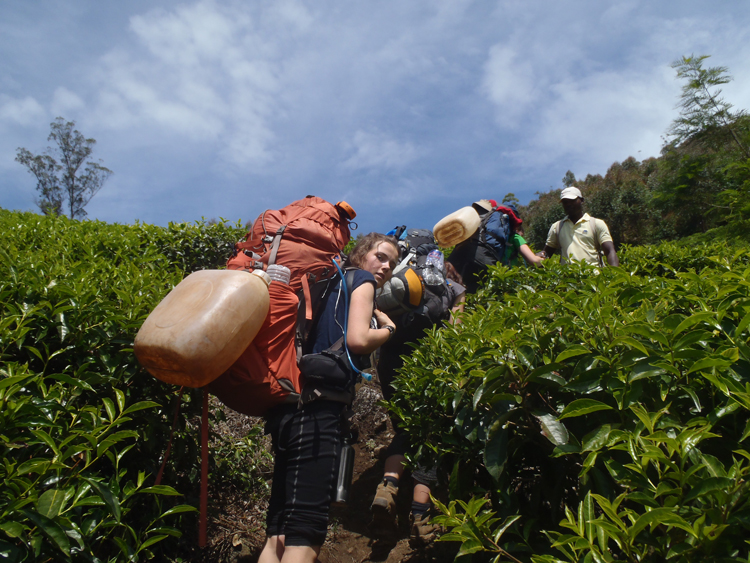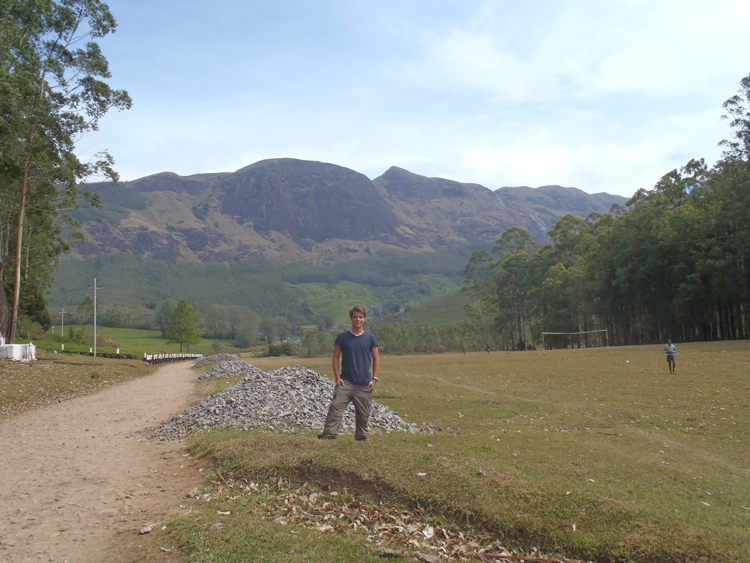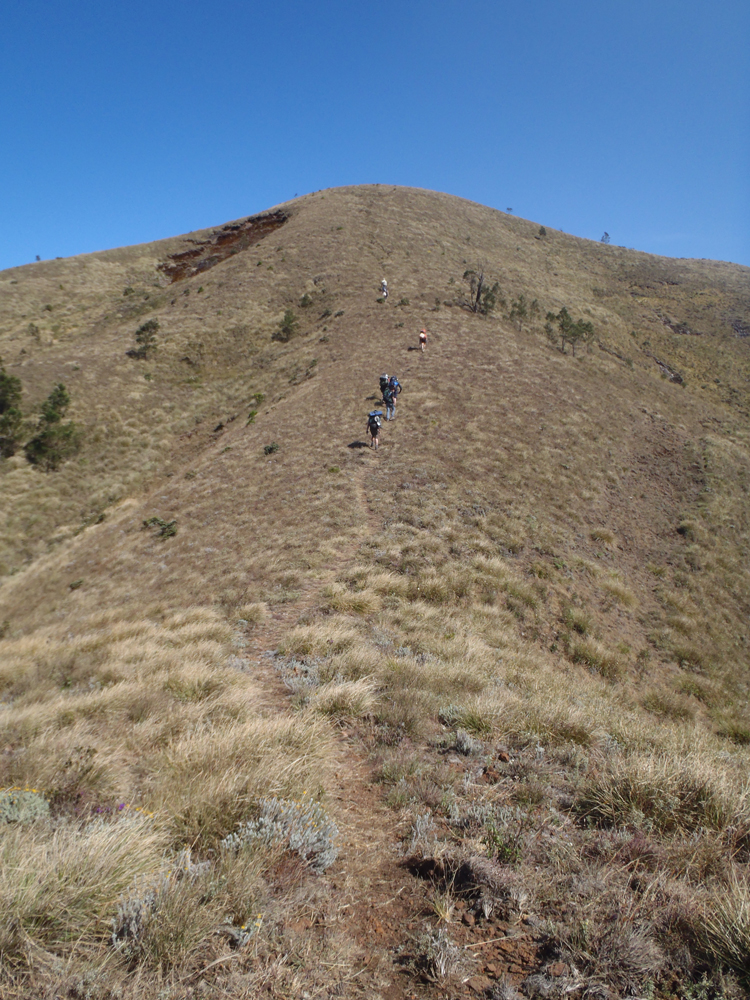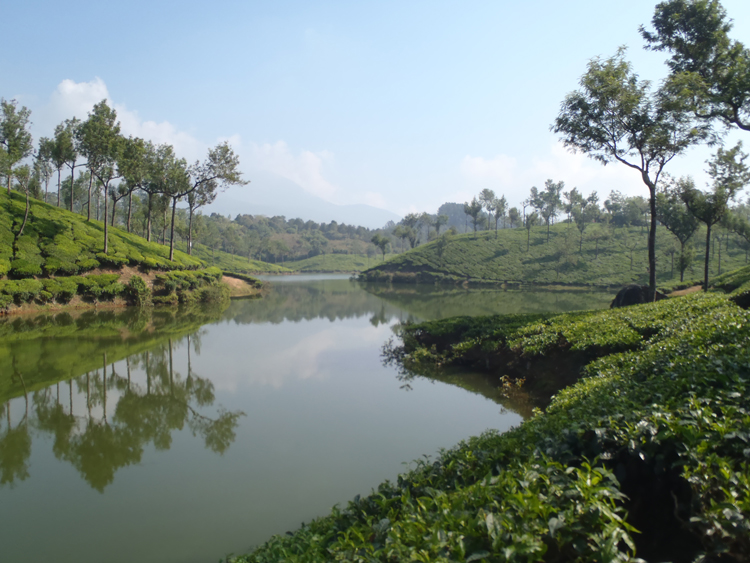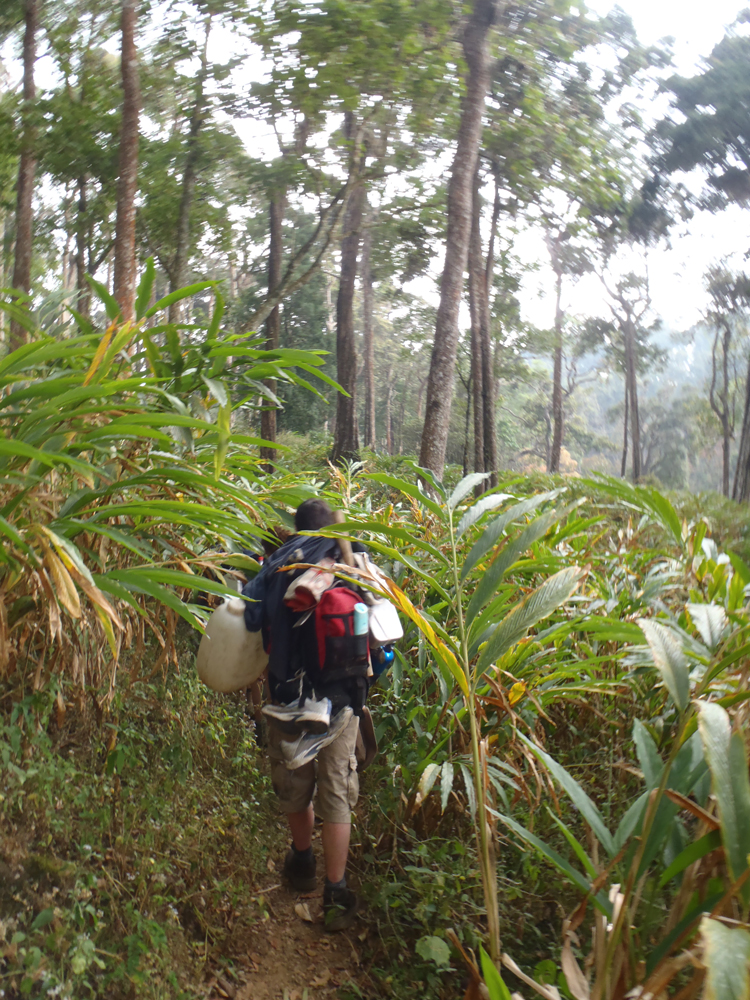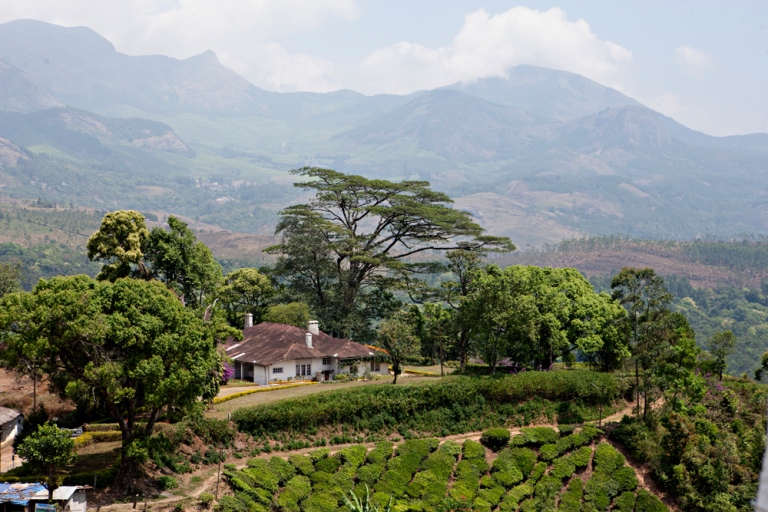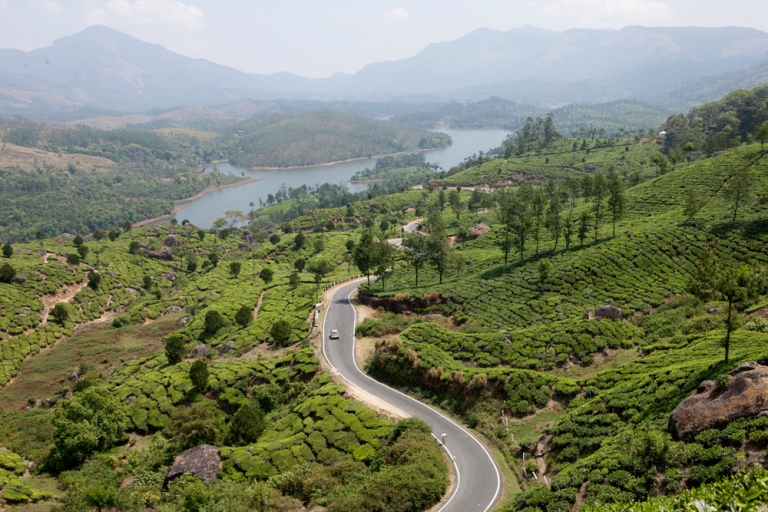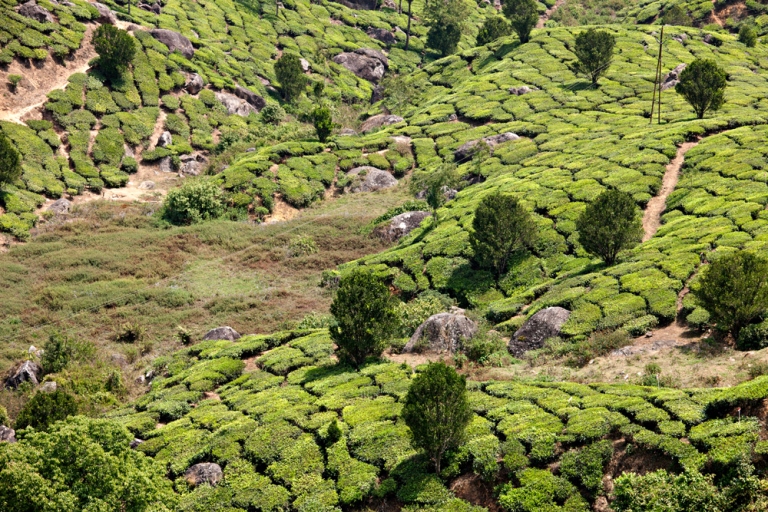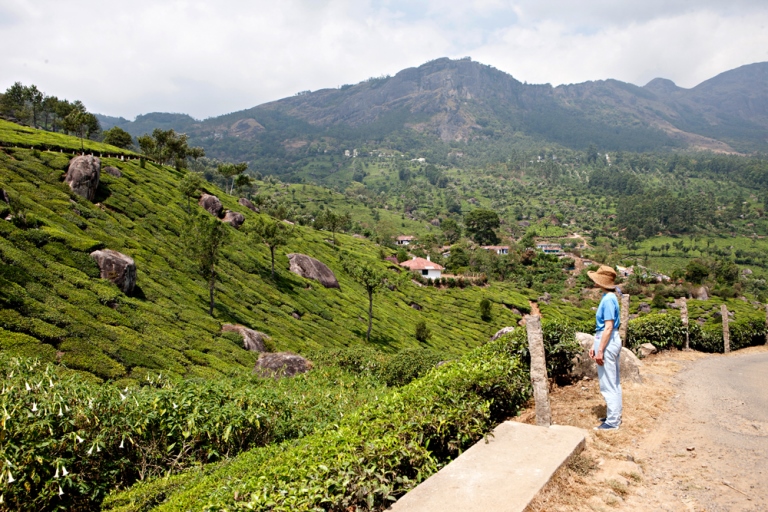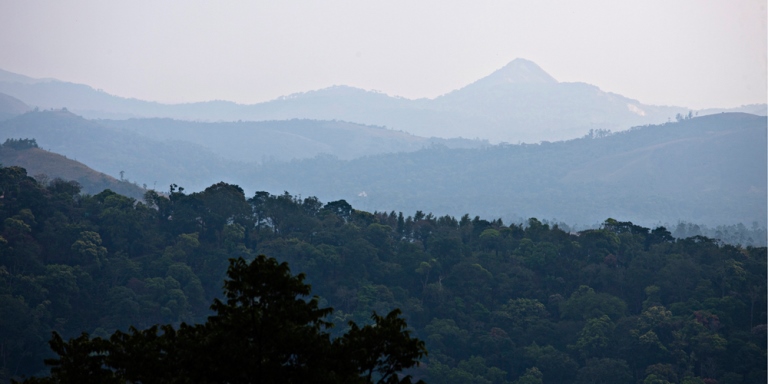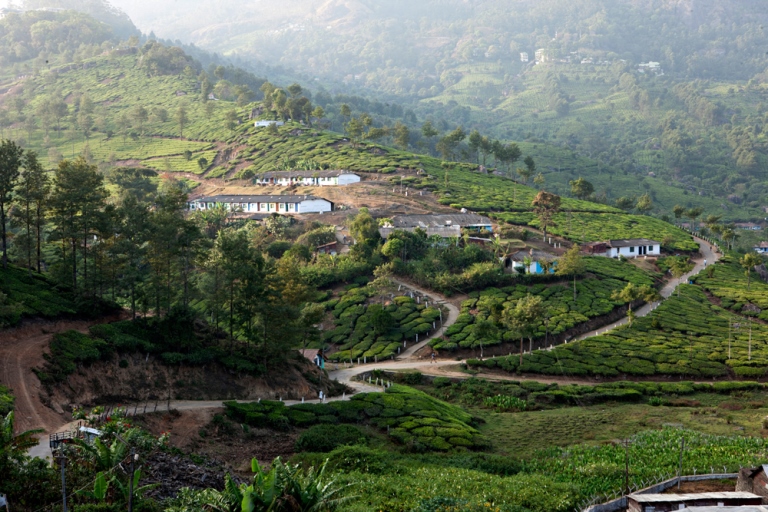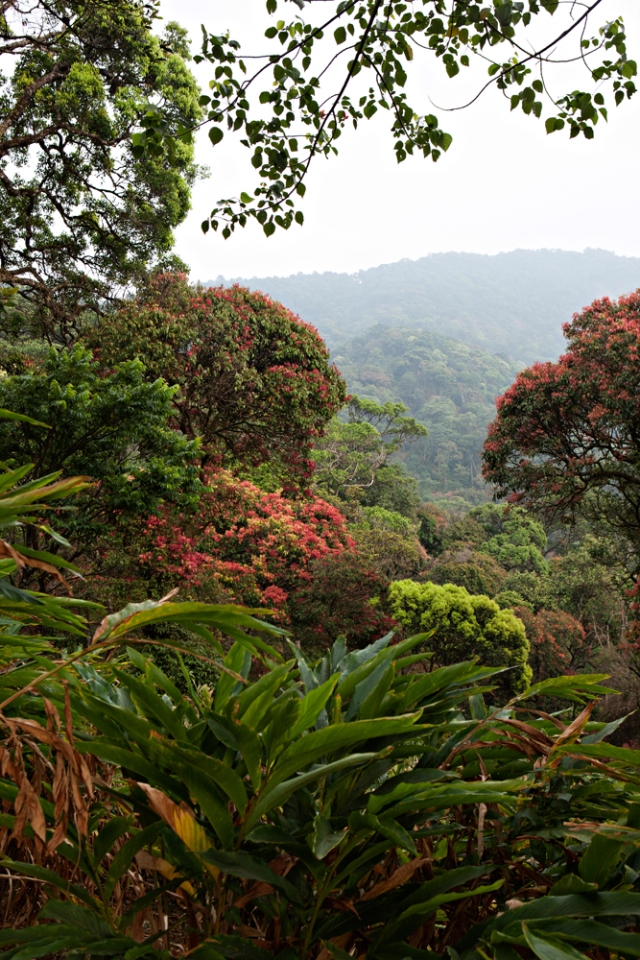Western Ghats
Key information: Western Ghats 
- Superb but surprisingly unvisited range in South Western India.
- Scenery ranges from grass and rock on high ground to tea and Cardamon plantations on the lower slopes to lush primary jungle below.
- Treks can vary in length from days to weeks. Possibly the best route consists of a crescent shaped trail that takes in a great deal of the finest hill country in the area, covering on the 3rd day the second highest peak in Southern India, at 2,500 metres (7,500 feet).
- Some sections of the trek are through busy and relatively uninteresting valley roads. You can either accept that these sections are necessary to get to the good bits, or you can consult with a guide operator and arrange a slightly different route.
- Kudu Travel do an excellent-looking expedition. Walkopedia partners, so recommended!
- See Guy Scott's account in the Community Comments, below.
Walkopedia rating
- Walkopedia rating86
- Beauty31
- Natural interest15
- Human interest12
- Charisma30
- Negative points2
- Total rating86
- Note: Neg: rubbish on main roads; heavy loads if self sufficient
Vital Statistics
- Length: Variable
- Maximum Altitude: 2,600m
- Level of Difficulty: Variable
This walk description page is at an early stage of development, and will be expanded over time. Your comments on this walk, your experiences and tips, and your photos are very welcome.
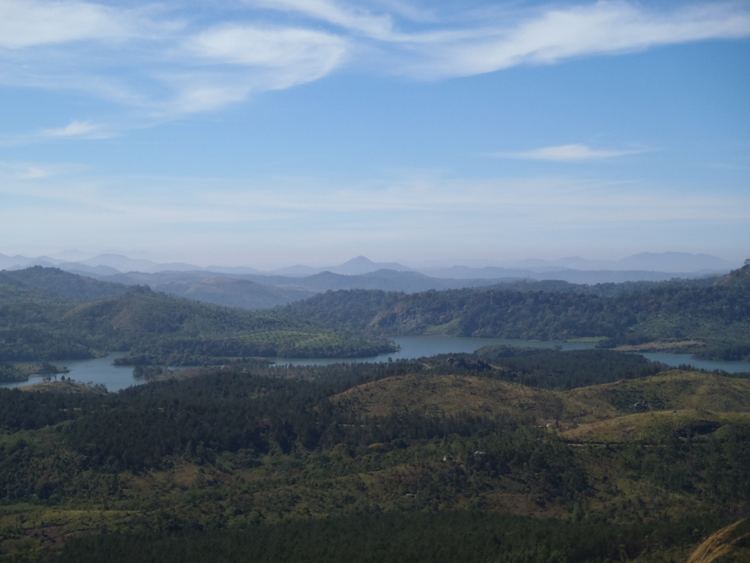
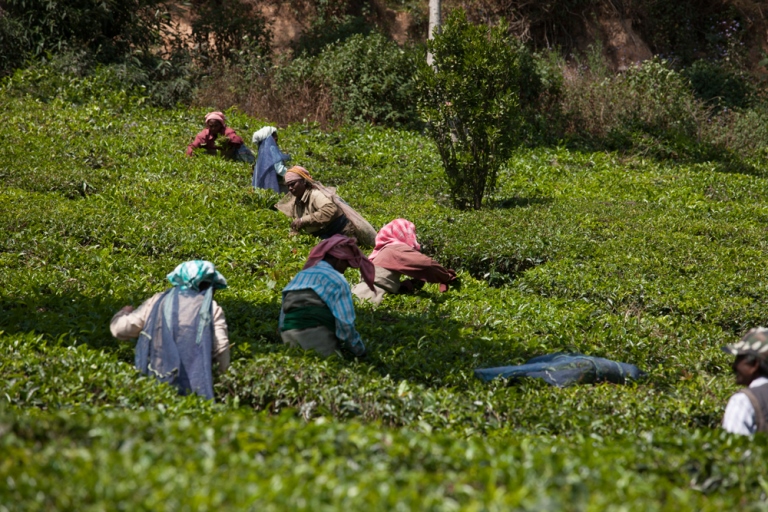
COMMUNITY COMMENTS AND PHOTOS
Name: Guy Scott
Posted on: 17/11/2011
An Explanation:
Before I start on an account of our 200 km trek over some of the most challenging terrain in the entire Southern Indian sub-continent I think it is fitting to set the scene as to how I found myself in that situation.
Early last year I signed myself up as a Volunteer with the charitable organization Raleigh International, looking for a good time, new faces and an experience rather different to the stereotype of the Gap Year �Full Moon Party�. I found all of these in spades after arriving at the Charity�s Indian Headquarters. About 30 minutes south of Mysore, Karnataka and consisting of nothing more than a few thatched roofs and a generator, this compact space housed for a few days every month 120 18-24 year old �Venturers�, all waiting for their next 3 week assignment.
By a stroke of luck, my first tasking was one of two Treks available, although I might have just as easily been assigned a job digging anti-elephant trenches, erecting electrified razor wire, constructing eco-sanitation units or teaching local schoolchildren how to do the air-guitar or the �Macarena�. All of these tasks were assigned to groups of about 15, who were sent far and wide throughout southern India.
My group was sent to the Western Ghat mountain range.
Days 1 and 2; JOURNEY; Highway Code 2.0
- Wake up 0430 for the journey to the start point, my alarm doesn�t go off.
- The entire group shuffled to the mess area of our base, grunting like a group of sleep-deprived swine.
- We left whilst it was still dark, the enthusiasm of the staff was almost unbearable at that hour but at least we were off!
- It was now that the noise that was to plague us constantly for the next 2 days started, coinciding with our arrival at the first main road;
- When an Indian driver is in any doubt about the rules of the road he leans hard on both the accelerator and the horn (deafening... thanks for asking) ... probably why India has one of the highest road mortality rates in the world.
- They drive like men possessed, swerving in and out of the flow of traffic like seasoned rally drivers.
- To them the road and its rules are mere guides; abstract constructions.
- As a result, when simultaneously faced with oncoming traffic and the desperate need to overtake, I have seen 2 or 3 drivers ignore the road altogether and whilst still doing at least 60 mph swerve onto the �hard shoulder�, full of old beggars and roadside stalls, and overtake on the other side.
- Cows: Considered sacred by locals, should a cow take a liking to a patch of grass growing in the middle of the road (also being used by quite literally hundreds of people) it must not be touched and should be treated as an immovable obstacle. The ensuing carnage never seems to remotely concern the idiot thing standing there with its big dewy eyes chewing the cud.
- We were issued with a pair of scruffy and extravagantly mustachioed Tamils for our journey. The reason for there being two of them was soon answered when we came to our first junction. Throwing caution to the wind he thrust the passenger window open, stuck his head and shoulders out and shouted down the crowded hordes trying their hardest to go in the opposite direction. We had met our replacement left-indicator, the light having been smashed.
- We soon found out that our pilot/co-pilot combo had a penchant for about 3 Bollywood songs, all played at absolutely bloody top volume and on repeat for 2 days straight. When I got out for the first pit-stop my ears were actually ringing.
- Eventually got to start point - MAYOOR/MAYUR - early on the second day. We came to a small village nestled in a deep valley, sheer faces of granite rose like walls on either side. After unloading all the gear from the bus we set off up a steep switchback trail that took us far above the valley floor.
- Came to a viewpoint that gave a broad panorama of the foothills of the Western Ghats. BEAUTIFUL.
- Arrived at a permanent camp near the summit of one of the heavily wooded and perilously steep satellite peaks that surround our objective, .............. .
- Got there for 5.00pm and was greeted by quite literally one of the most beautiful visages I have ever seen; the sun sank slowly below the western horizon whilst a tropical mist began to rise, covering the lower slopes of distant mountains barely visible in the twilight.
- Cooked a hearty dinner of tuna and pasta on out Trangia cookers and sat on the slope watching the unpolluted stars before going to bed.
Day 3; 05/02/11
- Wake at 0400, got kit together, same breakfast of cold porridge. At this altitude mornings are barely above freezing despite the fact that we are in Southern India.
- Stars still shining brilliantly.
- Have a rush to get kit together (I�m last, setting a precedent for the rest of the trip!)
- Set off, we spend the morning climbing into the higher portion of the Western Ghats and are rewarded by ever more dramatic scenery as we go on.
- Reach an abandoned settlement close to the top of the last peak before. Take a break and then bomb it to the top.
- I plug the iPod in and motor on up an extremely steep track; real hands-and-knees stuff here so soon we are all sucking in great lungfuls of air trying to keep up the pace.
- Turns into a race between a few of the blokes.
- We reach the top of the peak and are rewarded by our first view of the monster that is Meesapulimala. She stands like a monolith in the mid-morning haze, blocking our route. As the saying goes, when the going gets tough, the tough get going.
- To start the ascent we must first descend another couple of hundred feet along the ridge that links the two.
- We set off again, forcing ourselves on and making our way slowly to the point where the summit veers up from the ridge.
- As we climb breath becomes noticeably short. I wonder why until a guide helpfully points out that by the time we summit, we will be at almost 9,000 feet. Who�d have thought?
- The views are by far the most stunning I have yet come across, the plains that stretch out below us are obscured by a haze that gives the impression of standing high above cloud level; a real �summit-of-Everest� moment if ever there was one.
- We start to descend an incredibly steep slope, passing through brush that is all but impenetrable. The guides move up front and hack away with machetes. The going is still incredibly slow.
- We continued our descent; soon we were walking waist high through tea plantations that seemed to be nestled deep in every valley. As we reached a metaled road for the first time we turned the last corner and caught sight of a trio of ancient WW2-era Willis jeeps standing ready to take us down to our camp site.
- We jumped in, ecstatic to have a chance to rest our shattered legs, although the elation proved to be short-lived. As soon as the driver of our wreck set off down one of the perilously steep, suicidally thin roads that had been cut from the hillside we realised we had merely jumped from the frying pan and into the fire.
- Pot-holes make our heads bob in unison like a crowd of oversized novelty car toys.
- We finally made it to camp as night fell... left to survey the damage, we did well not to dwell on our chances of all making it the whole way through the 3 week trek. Even the sturdiest of us had really felt the pain and there was more to come.
Days 4 & 5; 06/02/11 & 07/02/11
- Time spent on survival day and building rafts.
Day 6; 08/02/11
- After the previous days having been spent high in the mountains, we now descended into the more humid and damp valleys at the foot of ....... Our route was obstructed by a large lake so we had spent the rest day cutting up bamboo, lengths of twine and old bicycle inner tubes in order to make rafts.
- Having done this, at first light we cast off from the mud bank and paddled through the swirling mist feeling for all the world like characters plucked from a Rudyard Kipling novel.
- We paddled for about an hour, our objective (a primitive slipway with dugout canoes crowded around) gradually coming into view as the mist lifted.
- It took us about an hour to unload and dis-assemble the rafts but once we had done so we made good headway.
- Pressing ahead we made our way through more tea plantations, serried ranks of perfectly manicured tea plants tended all the while by a small army of workers.
- At one point we found ourselves at an extremely old and rickety rope bridge across a tributary of the lake. We made our way slowly across one by one, our lumbering gait causing the whole thing to sway alarmingly from side to side.
- There are hammer and sickle flags everywhere here, due to the incredible amount of faith this part of India has for Communism as a means for lifting them out of grinding poverty.
- We walk through village after village, each seeming to be cast from the same mold; a line of small tidy houses in varying exotic colours, the small crowd of elders clustered around a table in the small �chai� (tea) shop, a small pile of rubbish by the roadside for good measure.
- As we walk on we begin to climb higher into a new set of foothills; as we progress the track becomes more treacherous and the gradients steeper. The vegetation has changed too, from Primary and Secondary tropical rainforest to the equally beautiful Cardamon plantations.
- The last 150 metres are hell; the campsite is situated atop a ridge that overlooks the misty rainforest below. Before we can rest, we must climb the ridge. 2 of our number find this last effort too much and must be man-handled the rest of the way up.
- We get there in darkness, but once dawn breaks the day after we are treated to a view akin to the Garden of Eden. Down below, but still close, we can hear a small herd of wild elephants making their way through the valley. All that�s visible of their passage is the manic movements of the trees they brush against as they go.
Day 7; 09/02/11; Rest Day
Day 8; 10/02/11
- I awake at 0400 and instantly regret it.
- Today we trek from - to - , a journey of about - miles.
- We spend most of the day walking trough the valleys on the main roads; every Indian driver that passes feels the need to blare his horn at us as a way of saying hello... that or screech to a halt and begin videoing our progress. Being treated like a herd of circus animals does not do much for morale!
- The journey takes us about 11 hours, giving us a pathetic average speed of ........ Some of our number are not feeling well and one of them has been sent to a local hospital with suspected tonsillitis.
- We reach camp before dusk which, given our track record so far, isn�t too bad.
- The camp has a large pond full of fish that can be used for swimming. Everyone dives into the putrid water and instantly feels cleaner than at any point in the previous week (this was probably our first shower)
- We catch fish and freshwater crab and season-to-taste. Delicious.
- I find out that tomorrow - my 19th birthday - I am to be day leader. And the re-supply drop is late, meaning that I must divide up all the provisions into equal weight and bulk and divide it amongst the group according to their ability to carry weight.... all at 2 in the morning tomorrow. Its going to be a long day.
- Last thing at night I brief the team on what we will encounter in the following day. I�m not feeling too well; I think the crab doesn�t agree with me.
Day 9; 11/02/11
- My birthday!
- I get up at 3:30 am in order to get myself squared away before dealing with the group and kit.
- I get everyone together and start to divide up the huge amounts of kit between 15 tired people at 4:00 in the morning in the dark.
- All goes well but, because the group knows what its like to be carrying their own body-weight on their backs, they are understandably reluctant to take more gear.
- With time pressing, I end up cramming the rest into my already overladen bag:
- My own personal possessions
- Clothes
- 3 litres of water
- Trangia and fuel
- Tarpaulin
- Communications kit
- 3 man tent
- 45 meals worth of food
- I look like a tortoise burdened with an oversized shell, i.e. ridiculous, all the more so considering some only take the equivalent of one item from the list.
- We get going in record time for a resupply day, leaving at 0645, but not before I am presented with a very fetching Birthday-boy costume made of a bin liner that I must wear for the rest of the day! It comes with a silly hat too. Brilliant.
- At first we walk along valley roads, stopping at a Chai shop after 7 km. I try and ignore the large fat man sweating heavily into the tea as he toils over the stove.
- Soon we ascend again, walking along a mountain ridge just above the cloud level. White vapor whips past at speed between the jagged peaks that surround us. Beautiful.
- We press on, checking maps and grid references as we go. Turning off the road we are forced to go up an incredibly steep track that we find extremely difficult in our heavily laden state.
- With the undulating terrain, 40 + degrees heat and extreme humidity, we reach the camp-site in a semi-conscious stupor BUT BEFORE LUNCH TIME!!!! (an unprecedented event)
- We relax for a few hours, I get called over and am treated to a surprise birthday party. Cake has been brought back with the team member newly returned from hospital(and therefore civilisation).
- When everyone is stuffed we play fluffy bunny, where the competitor must stuff as much cake into his/her mouth as possible and shout �fluffy bunny!� at the top of their voice. Absolute chaos ensues.
- I de-brief and hand over to the next day-leader. Job done.
Day 10; 12/02/11
- Get up at 0400... again.
- We get going, and are soon walking through a cluster of massive wind turbines made yet bigger by the dramatic early morning sun.
- After a while we get to a small ridge line that we continue along. Eventually we arrive at a pair of huge, ancient statues with a cluster of touristy shops nearby. We stop for Chai.
- We rejoin the ridge line and begin to climb. The gradient becomes steeper and the drop on either side more pronounced.
- Over to the eastern side of the ridge we see a strange sight... the plains below are billiard-table flat and stretch away into the distance. We are on the border between Kerela and Tamil Nadu.
- Our speed really is starting to decline now and one of our group is really feeling the strain.
- [She collapses into the dust and is helped to her feet again in a cycle that is to be repeated for the rest of the day every 10 minutes.]
- The rest of the group starts to sing stupid songs in order to keep spirits up, we all go a bit loopy.
- By now the hills are rolling rather than craggy and remind me of England... Somerset perhaps.
- We come to a cricket pitch that uses the hard surface of the dirt track as the wicket. Game suspended to let us pass. �Idiot travelers stopped play�
- The sky grew darker and we ended up manhandling our flagging team member along, physically dragging her in an effort to get to the campsite.
- We reach camp 16 hours after we left the previous one. Our average speed was 1 km/hour. I can�t say quite how frustrated I was, but there was obviously no alternative. It is because of our incredibly slow speed that we are waking up at 0400 rather than a more sane hour. There are not enough hours in the day.
Day 11; 13/02/11
- We awake at 0400, this really is getting boring rather quickly. I can�t find my stuff so we end up leaving the site at 0630. The first part of the day�s trek took us along the crest of a low ridge, feeling rather rough after the previous days escapades!
- Luckily today�s trek is along valley roads and was consequently fairly straightforward. That said, the barrage of car horns sounded in greeting by the locals grew from a novelty to an irritation; our smiles of acknowledgment were wearing thin.
- The group spent most of the day dodging ancient Willis Jeeps and rickety Auto-rickshaws driven by wild eyed and extravagantly mustachioed old Indians.
- In a pleasant departure from usual form we got in for about 12:00 noon so we were free to spent the rest of the day snoozing :)
Day 12; 14/02/11
- The going up until that point had been so slow that we were roused awake at the ungodly hour of 0230. Sorry, lets just look at that figure again..... 0230. Jesus wept.
- The plus side of getting up at this hour is that the stars really were some of the best I have ever encountered. Without any large built up areas nearby there was no light pollution to spoil the view. As we walk we are greeted at every gate by a fierce sounding dog attempting to bite through its front gate in an effort to tear us limb from limb.
- After a 7 hour walk we got into camp at 3:00pm. Good going for us.
- We found ourselves deep inside a large Cardamon plantation, surrounded by creepy crawlies and vegetation. Someone had set up a system of wires running from tree to tree to allow the hordes of red soldier ants to pass freely throughout the sight without being encumbered by our presence. How thoughtful!
- Some of us take advantage of a rock pool and have a dip. Brilliant.
- The area is well known for its particularly tongue-burning chilies... how could we pass up a challenge like that? Gathering up 4 of the most excruciating-looking chillies we could find, 4 poor unfortunate souls made the mistake of eating them. For 30 seconds nothing happened. Then, all hell broke loose. Someone started screaming, another collapsed like a sack of potatoes and curled up groaning. All went bright red, eyes streaming. No sympathy from the rest of the group.
Day 13; 15/02/11
- Yet another early wake up, we left the Cardamon plantation early and were immediately faced with a steep uphill struggle. Not how I would have started my ideal Sunday morning but needs must.
- The steep uphill gradient soon gave way to the undulating terrain of tea country. The atmosphere began to dry out, a cheering prospect after 5 days of damp tropical conditions.
- We soon came to a peculiar village perched on a hillside with magnificent views of the surrounding tea-fields below. In a departure from the normal mud-brick and thatch house, all the buildings here had a Wild-west wood board look, undoubtedly because it had been built during the days of British rule as a Headquarters for the tea growing operation below.
- We climbed still further up the hillsides crowded with vegetation, coming to rest by a huge stone folly that can only have been teleported from Regency-era Derbyshire. No sign of Mr. Darcy though.
- Made it into camp fairly early (by our standards) and was greeted by a sight for sore eyes; our stop for tomorrow�s rest-day. Giant palm trees swayed by a cool river that flowed slow and deep. Exotic birds called out from the far tree line and a bamboo raft bumped gently against the bank.
- Walking into a nearby Chai shop we asked the wizened old man how long he was open for... after 5 minutes spent conferring with is equally antiquated friends he came back with the answer. Open since the year 1933. Brilliant.
- Lay down by the banks of the river with a book, a glass of Kerela tea and a packet of local biscuits. Watched night fall and the fireflies dance across the water.
Day 14; 16/02/11; Rest day
Day 15; 17/02/11
- We woke at 0200 in order to keep to schedule, an utterly brutal idea after a 10:00am lie in the previous morning.
- Initially we climbed out of our homely valley, through yet more tea plantations. The full moon shone with a radiance I have yet to see since, illuminating the hills partially shrouded in mist. They say that Kerela is �god�s own country�; they don�t know the half of it.
- At about 4:30 a klaxon sounded in the distance, presumably to awaken the plantation workers sleeping in their dormitories.
- We climb higher and are met wherever we go with Hindu ritual music seeming to emanate from the very hills themselves. It is a surreal scene looking out across the mist-shrouded mountains. Pandi, one of the locals trekking with us, tells me that the music is played every morning by the Hindu temples that seem to be everywhere, ostensibly as a form of nationwide alarm clock.
- Mile after mile we are presented with isolated and strikingly beautiful settlements perched precariously upon the hillsides. Everyone stares at us, some with genuine excitement, others with undisguised contempt (the exception rather than the rule)
- Soon after passing a large village we find our path partially obscured by gorse and thorn bushes. We push on.
- About 20 minutes later we discovered that Pandi was not with us and, turning back, spent about an hour combing the tea plantations we had just covered. When this search bore no fruit myself and a few others were sent back to the town to look for him. Speaking to an old man in his cafe we gathered that he had begged the equivalent of £10 from the locals, had a slap-up breakfast and hopped the first bus home to Tamil Nadu, 250 km away. It soon transpired that he had taken with him one of the meths cookers, the coffee (!) and the sugar. Cheers Pandi.
- There was a sense of betrayal that Pandi would leave so close to the finish, after the rest of the group had put so much effort into returning as an complete group; bastard!
- We continue on our way (minus one Trekker), following a long, exposed and winding road with motorists happily tooting their horns at us every step of the way. This was starting to get a tad irritating.
- On our way we stopped at the cafeteria of the Karnatica State Agricultural College for a bite to eat; the first meat for a week and Parottas to die for. We leave here contented and happy about the world.
- We�d been told that the next camp-site was some kind of resort so the group was euphoric; showers, clean clothes and maybe even a bed to crash out in. NIRVANA!
- 3 hours later we arrive at an exposed and swampy field sitting on the top of a small ridge; nothing there save a dilapidated building with no walls and an old shit-house that didn�t work. What an anti-climax.
- Today�s trek has been tough; at 23km it has been the longest so far. Despite this the team has been comparatively fast today so we come into camp at 6pm. We have been trekking for 15 hours straight.
Day 16; 18/02/11
- Yet another 0200 wake up, these really are starting to get on my nerves; it takes an almost superhuman effort to get myself out of my sleeping bag so no change there.
- Mist had descended overnight and now shrouded the surrounding hilltops. Coupled with the derelict buildings and the remoteness of the site, it created quite an oppressive atmosphere.
- We set off, still in the dark, through a series of deserted and ramshackle villages. These looked to me like the badlands of Afghanistan, the picture completed by a burned out jeep abandoned by the side of the road. Dogs barked in the distance.
- As the sun rose all menace was stripped from the scene, revealing a countryside rich with cardamon and marred only the rubbish strewn by the side of the road (you get used to this fairly soon after arriving in India after all)
- The group stopped for Chai about 10km into today�s hike; the area is very poor and we pass a dog dead and rotting by the side of the road. Makes a change from the usual litter I suppose.
- As usual, the local cuisine served by these tiny chai-houses was simply amazing; I ordered a traditional Kerela breakfast of rice dumplings and a curry sauce, washed down with copious amounts of local tea. Delicious.
- The day leader for today really cracked the whip and, probably tired of all the moaning and stopping, kept the pace up. No stops for that day were longer than 5 minutes; not good after 13 hours straight of walking!
- Descending finally into the valley that was to be our temporary home, we were greeted by a sight of almost overawing beauty; tall, slender palms swayed slowly in a breeze laden with the scent of the jungle. Below them the paddy fields were full of mature rice plants and above the immense presence of mountains, standing sentinel over a slice of paradise too beautiful for the presence of the hordes of Koh Phagnang or Phi Phi. Ironic then that the latter-day setting for the �90s novel The Beach is miles from the sea.
- A group of locals mid-way through a game of cricket invited us over to play. Seeing the obvious youth in their faces (they couldn�t have been older than 16) we saw an opportunity to beat them at their own game. I step up to the crease with no protection whatsoever and prepare to slog them for 6.
- The bowler makes his approach and abruptly I hear a heavy �thwack� of leather on leather. I didn�t even get a chance to raise the bat. These boys are good. An hour later we decide to call it a game and beat a retreat back to camp.
- We dose off beneath stars un-obstructed by haze or light pollution. The milky way is clearly visible and all is right with the world.
Day 17 - 19/02/11
- Another early wake-up, really very tired of this at this point.
- The group emerges from their tents to see the mountains shrouded in mist, all feel sorry to leave the valley behind but we must press on.
- 2 of the locals we were playing cricket with accompany us down the extremely steep sides of the hill we are descending. In parts a set of ancient steel railings help us along but its mostly just a rocky path. The kids play Rihanna and Madonna songs though their phones to keep us going (Western culture for the win!) and we are soon down into the valley floor.
- This unfortunately signals the start of a long and slow climb up to our final camp-site 13km away, a journey that will take us from the foothills back up to some of the tallest mountains in the area.
- We continue the ascent along a road carved out of the hillside and stop about 8km in for our last cup of chai of the trek; very emotional!
- After the end of the last chai stop we start the ascent in earnest; the road becomes horribly steep and, in 100% humidity and 35/40 degree heat we are soon in a dire state. It looks like we�ve all gone swimming after about half an hour.
- Nearing the end, we are all so focussed on the finish that by 4.00pm none of us have yet thought of lunch. We just want to get there.
- Pressing forward, we reach the campsite at about 4.30 having done 15 km in 11 hours. More terrible progress BUT we are pretty much there!!
- We are led by the guides up to the top of a mountain where stands a solitary, peculiar circular house. Following the guides we walk to it, around the back and back the way we came for another 50 metres. They are messing with us, we reached the finish before the house but they wanted to see us all suffer a little bit more!
- The group settles down to our �last supper� and the guides bring out a huge dish of sweet coconut curry; absolutely amazing and a real credit to them. Over the period we have been trekking we have all bonded with the guides and will be sorry to see them go. We couldn�t have done it without them! Legends.
- A few of the blokes, myself included, stand up to sing a re-make of Journey�s �Don�t Stop Believing� with lyrics about searching for Pandi and trekking in general. Talk about ending on a high note!
- All in all its been a great day and there is a good vibe throughout the group; we bed down atop the mountain surrounded by beautiful scenery with the same feeling one gets on the last day of school before the holidays.
Day 18 and 19; 20/02/11 & 21/02/11; Return Leg.
- There only remains a short 2 km hike down to the nearest serviceable road, followed by another monster 2 day bus ride back to Mysore. For all intents and purposes the job is done and we are all over the moon. A carnival atmosphere is prevalent.
Name: Jwngdow
Posted on: 29/03/2016
Hello Guy Scott, I read your journey and it really made me wanna do the trek but I could not find any trek guide in your story. It would be really helpful if you could provide me the trek route/ itinerary you took for this trek. Thank you
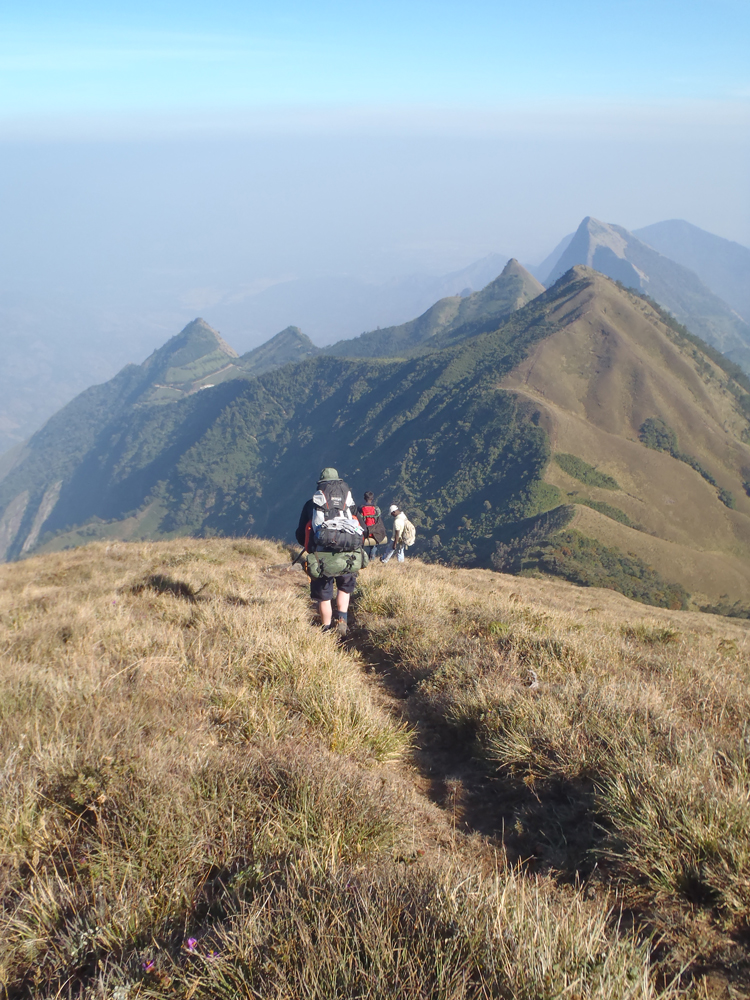
Other accounts: share your experiences
Your comments on this walk, your experiences and suggestions, and your photos are very welcome. Where appropriate, you will be credited for your contribution.
Anyone planning an expedition to this place should see further important information about this walk.
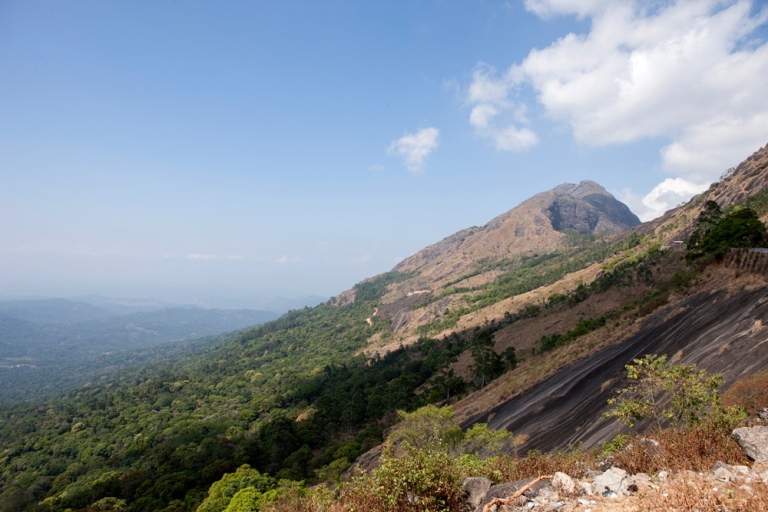
Responsible travel matters, a lot. How you travel will make a real difference - for better or worse. PLEASE consider this when making plans. Read more



